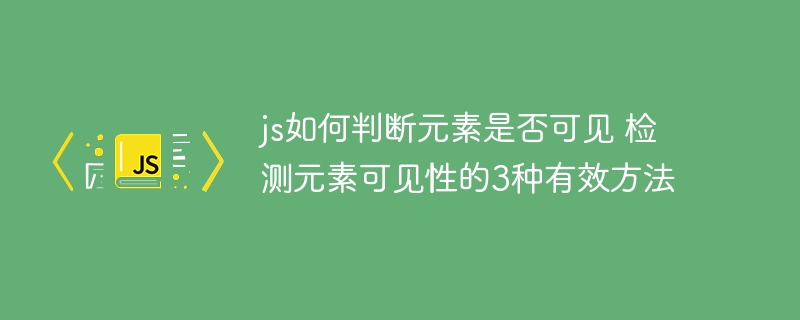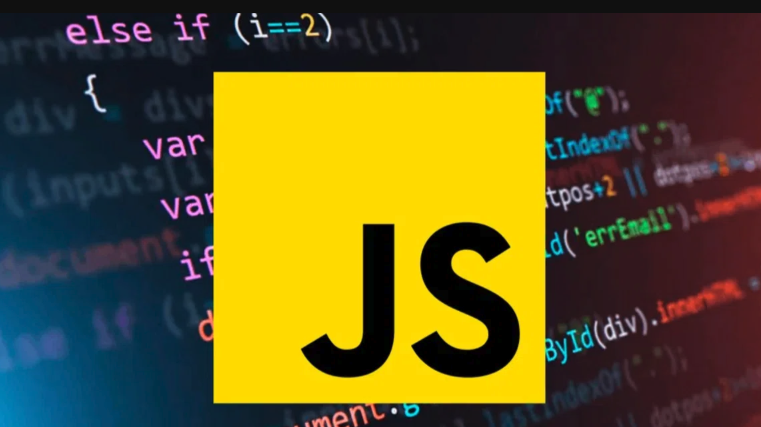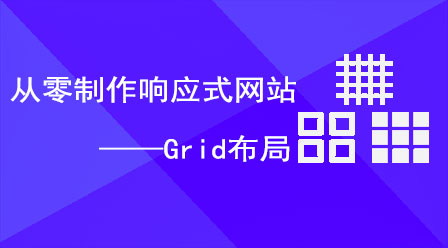JS实现检测元素可见性,这3种方法超实用!
时间:2025-06-12 19:20:35 354浏览 收藏
还在为JavaScript中判断元素是否可见而烦恼吗?本文为你总结了3种超简单且有效的JS判断元素可见方法!从最基础的offsetWidth和offsetHeight判断,到更准确的getClientRects().length判断,再到综合考虑display、visibility、opacity等多种隐藏情况的终极方法,逐一详细讲解。同时,还针对position: fixed元素和滚动容器内的元素,提供了相应的解决方案。更重要的是,文章还分享了避免频繁计算,利用requestAnimationFrame优化性能的实用技巧。快速掌握这些方法,让你的JS代码更加健壮高效!
判断JavaScript中元素是否可见有3种有效方法。1. 使用offsetWidth和offsetHeight判断,若均大于0则通常可见,但可能受transform或overflow影响;2. 使用getClientRects().length判断,若长度为0则不可见,此方法更准确;3. 综合判断display、visibility、opacity、offset属性及祖先元素的overflow,并递归检查父元素是否裁剪。此外,position: fixed元素需额外考虑祖先元素的transform,而滚动容器内元素需单独判断是否在可视区域。为优化性能,应避免频繁调用计算方法,建议结合requestAnimationFrame减少重绘重排。

判断JavaScript中元素是否可见,核心在于检查元素的offsetWidth、offsetHeight、getClientRects().length等属性,以及其父元素的样式和位置。要考虑元素是否被隐藏(display: none),透明度(opacity: 0),或者被祖先元素裁剪等情况。

检测元素可见性的3种有效方法

方法一:基于offsetWidth和offsetHeight的判断
这是最简单直接的方法。如果一个元素的offsetWidth和offsetHeight都大于0,通常就认为它是可见的。但要注意,如果元素被transform: scale(0)缩放到0,或者其父元素设置了overflow: hidden,即使offsetWidth和offsetHeight大于0,元素实际上也可能不可见。

function isVisible(el) {
return el.offsetWidth > 0 && el.offsetHeight > 0;
}
// 示例
const myElement = document.getElementById('myElement');
if (isVisible(myElement)) {
console.log('元素可见');
} else {
console.log('元素不可见');
}方法二:基于getClientRects的判断
getClientRects()方法返回一个元素的CSS盒子模型的边界矩形集合。如果这个集合的长度为0,那么元素通常是不可见的。这种方法能更准确地判断元素是否真的占据屏幕空间,因为它考虑了元素是否被裁剪、隐藏等情况。
function isVisible(el) {
return el.getClientRects().length > 0;
}
// 示例
const myElement = document.getElementById('myElement');
if (isVisible(myElement)) {
console.log('元素可见');
} else {
console.log('元素不可见');
}方法三:综合判断,考虑各种隐藏情况
为了更准确地判断元素是否可见,我们需要综合考虑各种可能导致元素隐藏的情况,例如display: none、visibility: hidden、opacity: 0,以及元素是否被祖先元素裁剪等。
function isVisible(el) {
if (!el) return false;
// 检查 display: none
if (getComputedStyle(el).display === 'none') return false;
// 检查 visibility: hidden 或 collapse
if (getComputedStyle(el).visibility === 'hidden' || getComputedStyle(el).visibility === 'collapse') return false;
// 检查 opacity: 0
if (getComputedStyle(el).opacity === '0') return false;
// 检查 offsetWidth 和 offsetHeight
if (el.offsetWidth <= 0 || el.offsetHeight <= 0) return false;
// 检查 getClientRects
if (el.getClientRects().length === 0) return false;
// 递归检查祖先元素
let parent = el.parentNode;
while (parent) {
if (getComputedStyle(parent).overflow === 'hidden' && !isElementInViewport(el)) return false; // 检查是否被父元素裁剪
parent = parent.parentNode;
}
return true;
}
function isElementInViewport(el) {
const rect = el.getBoundingClientRect();
return (
rect.top >= 0 &&
rect.left >= 0 &&
rect.bottom <= (window.innerHeight || document.documentElement.clientHeight) &&
rect.right <= (window.innerWidth || document.documentElement.clientWidth)
);
}
// 示例
const myElement = document.getElementById('myElement');
if (isVisible(myElement)) {
console.log('元素可见');
} else {
console.log('元素不可见');
}如何处理position: fixed元素?
position: fixed的元素脱离了文档流,其可见性判断相对简单。只需要考虑display、visibility、opacity以及offsetWidth和offsetHeight即可。通常不需要检查父元素的overflow属性,因为fixed元素相对于视口定位,不受父元素裁剪的影响。但是,如果fixed元素的祖先元素设置了transform属性,那么fixed元素的行为会受到影响,需要额外考虑。
如何判断元素是否在滚动容器内可见?
如果元素在一个设置了overflow: auto或overflow: scroll的滚动容器内,需要判断元素是否在该容器的可视区域内。这可以通过比较元素的位置和滚动容器的滚动位置来实现。
function isElementInScrollableContainer(el, container) {
const elRect = el.getBoundingClientRect();
const containerRect = container.getBoundingClientRect();
return (
elRect.top >= containerRect.top &&
elRect.left >= containerRect.left &&
elRect.bottom <= containerRect.bottom &&
elRect.right <= containerRect.right
);
}
// 示例
const myElement = document.getElementById('myElement');
const scrollableContainer = document.getElementById('scrollableContainer');
if (isElementInScrollableContainer(myElement, scrollableContainer)) {
console.log('元素在滚动容器内可见');
} else {
console.log('元素在滚动容器内不可见');
}性能优化:避免频繁计算
频繁调用getComputedStyle和getBoundingClientRect会影响性能。建议在需要时才进行计算,并尽量缓存结果。例如,可以使用requestAnimationFrame来优化滚动事件中的可见性判断。
let lastScrollTop = 0;
window.addEventListener('scroll', function() {
const scrollTop = window.pageYOffset || document.documentElement.scrollTop;
if (scrollTop !== lastScrollTop) {
requestAnimationFrame(function() {
// 在这里执行可见性判断
const myElement = document.getElementById('myElement');
if (isVisible(myElement)) {
console.log('元素可见');
} else {
console.log('元素不可见');
}
lastScrollTop = scrollTop;
});
}
});以上就是《JS实现检测元素可见性,这3种方法超实用!》的详细内容,更多关于JavaScript,性能优化,元素可见性,offsetWidth/offsetHeight,getClientRects()的资料请关注golang学习网公众号!
-
502 收藏
-
501 收藏
-
501 收藏
-
501 收藏
-
501 收藏
-
220 收藏
-
283 收藏
-
311 收藏
-
476 收藏
-
266 收藏
-
283 收藏
-
314 收藏
-
346 收藏
-
123 收藏
-
262 收藏
-
181 收藏
-
226 收藏
-

- 前端进阶之JavaScript设计模式
- 设计模式是开发人员在软件开发过程中面临一般问题时的解决方案,代表了最佳的实践。本课程的主打内容包括JS常见设计模式以及具体应用场景,打造一站式知识长龙服务,适合有JS基础的同学学习。
- 立即学习 543次学习
-

- GO语言核心编程课程
- 本课程采用真实案例,全面具体可落地,从理论到实践,一步一步将GO核心编程技术、编程思想、底层实现融会贯通,使学习者贴近时代脉搏,做IT互联网时代的弄潮儿。
- 立即学习 516次学习
-

- 简单聊聊mysql8与网络通信
- 如有问题加微信:Le-studyg;在课程中,我们将首先介绍MySQL8的新特性,包括性能优化、安全增强、新数据类型等,帮助学生快速熟悉MySQL8的最新功能。接着,我们将深入解析MySQL的网络通信机制,包括协议、连接管理、数据传输等,让
- 立即学习 500次学习
-

- JavaScript正则表达式基础与实战
- 在任何一门编程语言中,正则表达式,都是一项重要的知识,它提供了高效的字符串匹配与捕获机制,可以极大的简化程序设计。
- 立即学习 487次学习
-

- 从零制作响应式网站—Grid布局
- 本系列教程将展示从零制作一个假想的网络科技公司官网,分为导航,轮播,关于我们,成功案例,服务流程,团队介绍,数据部分,公司动态,底部信息等内容区块。网站整体采用CSSGrid布局,支持响应式,有流畅过渡和展现动画。
- 立即学习 485次学习
